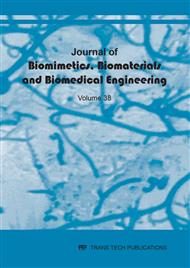[1]
T. Nakano, M. Nakamura, and K. Murata, Investigation of exquisite, powerful, and aesthetic nature of materials of plants origin. (2012).
Google Scholar
[2]
R. Salvador,R. González-Peña,R. Cibrián, M. Buendía, F. Mínguez,V. Micó, J. A. Carrión,J. J. Esteve-Taboada,T. Molina-Jiménez, S. Simón; E. Pérez, Deformation analysis in biomaterials using digital speckle interferometry. (2007).
DOI: 10.1117/12.726639
Google Scholar
[3]
S. Ramakrishna, M. Ramalingam, T .S. Sampath Kumar, W. O. Soboyejo Biomaterials: a nano approach. 2016: CRC Press.
Google Scholar
[4]
M.D. Monsia, A Mathematical Model for Predicting the Relaxation of Creep Strains in Materials. Physical Review & Research International, 2012: pp.107-124.
Google Scholar
[5]
B. Basu, Mechanical Properties of Biomaterials, in Biomaterials for Musculoskeletal Regeneration. 2017, Springer. pp.175-222.
Google Scholar
[6]
Z. G. Karaji, R. Hedayati, B. Pouran, I. Apachitei, A.A. Zadpoor , Effects of plasma electrolytic oxidation process on the mechanical properties of additivelymanufactured porous biomaterials. Materials Science and Engineering: C, 2017. 76: pp.406-416.
DOI: 10.1016/j.msec.2017.03.079
Google Scholar
[7]
A.W. Chan, and R.J. Neufeld, Modeling the controllable pH-responsive swelling and pore size of networked alginate based biomaterials. Biomaterials, 2009. 30(30): pp.6119-6129.
DOI: 10.1016/j.biomaterials.2009.07.034
Google Scholar
[8]
R.H. Ewoldt, A.E. Hosoi, and G.H. McKinley, Nonlinear viscoelastic biomaterials: meaningful characterization and engineering inspiration. Integrative and comparative biology, 2009. 49(1): pp.40-50.
DOI: 10.1093/icb/icp010
Google Scholar
[9]
R. C. de Guzman, J. M. Saul, M. D. Ellenburg, Mechanical and biological properties of keratose biomaterials. Biomaterials, 2011. 32(32): pp.8205-8217.
DOI: 10.1016/j.biomaterials.2011.07.054
Google Scholar
[10]
O. H. Campanella, H. Sumali, B. Mert, and B. Patel, The Use of Vibration Principles to Characterize the Mechanical Properties of Biomaterials. INTECH Open Access Publisher, (2011).
DOI: 10.5772/22858
Google Scholar
[11]
N. Weber, A. Pesnell, D. Bolikal, J. Zeltinger, and J. Kohn Viscoelastic properties of fibrinogen adsorbed to the surface of biomaterials used in blood-contacting medical devices. Langmuir, 2007. 23(6): pp.3298-3304.
DOI: 10.1021/la060500r
Google Scholar
[12]
S. Mukherjee, D. Goswami, and B. Roy, Solution Of Higher-Order Abel Equations By Differential Transform Method. International Journal of Modern Physics C, 2012. 23(09): p.1250056.
DOI: 10.1142/s0129183112500568
Google Scholar
[13]
M. Garg, P. Manohar, and S.L. Kalla, Generalized differential transform method to space-time fractional telegraph equation. International Journal of Differential Equations, (2011).
DOI: 10.1155/2011/548982
Google Scholar
[14]
X. Chen, J.X. Lou, and Y. Dai. Differential Transform Method for the Brooks-Corey Model. in Applied Mechanics and Materials. 2014. Trans Tech Publ.
Google Scholar
[15]
T. M. Elzaki, E. M. A. Hilal, Solution of linear and nonlinear partial differential equations using mixture of Elzaki transform and the projected differential transform method. Math. Theo. & Model, 2012. 2: pp.50-59.
DOI: 10.5772/intechopen.94598
Google Scholar
[16]
R.K. Saeed, and B. Rahman, Differential Transform Method for Solving System of Delay Differential Equation. Australian Journal of Basic and Applied Sciences, 2011: pp.201-206.
Google Scholar
[17]
N.A. Obeidat, M.S. Rawashdeh, and M. Alquran, An Improved Approximate Solutions to Nonlinear PDEs Using The ADM and DTM. (2014).
Google Scholar
[18]
O.O. Agboola, A.A. Opanuga, J.A. Gbadeyan, Solution Of Third Order Ordinary Differential Equations Using Differential Transform Method. Global Journal of Pure and Applied Mathematics. Volume 11, Number 4, 2015, pp.2511-2517.
Google Scholar


